1995 CHEVROLET S10 tires
[x] Cancel search: tiresPage 260 of 354
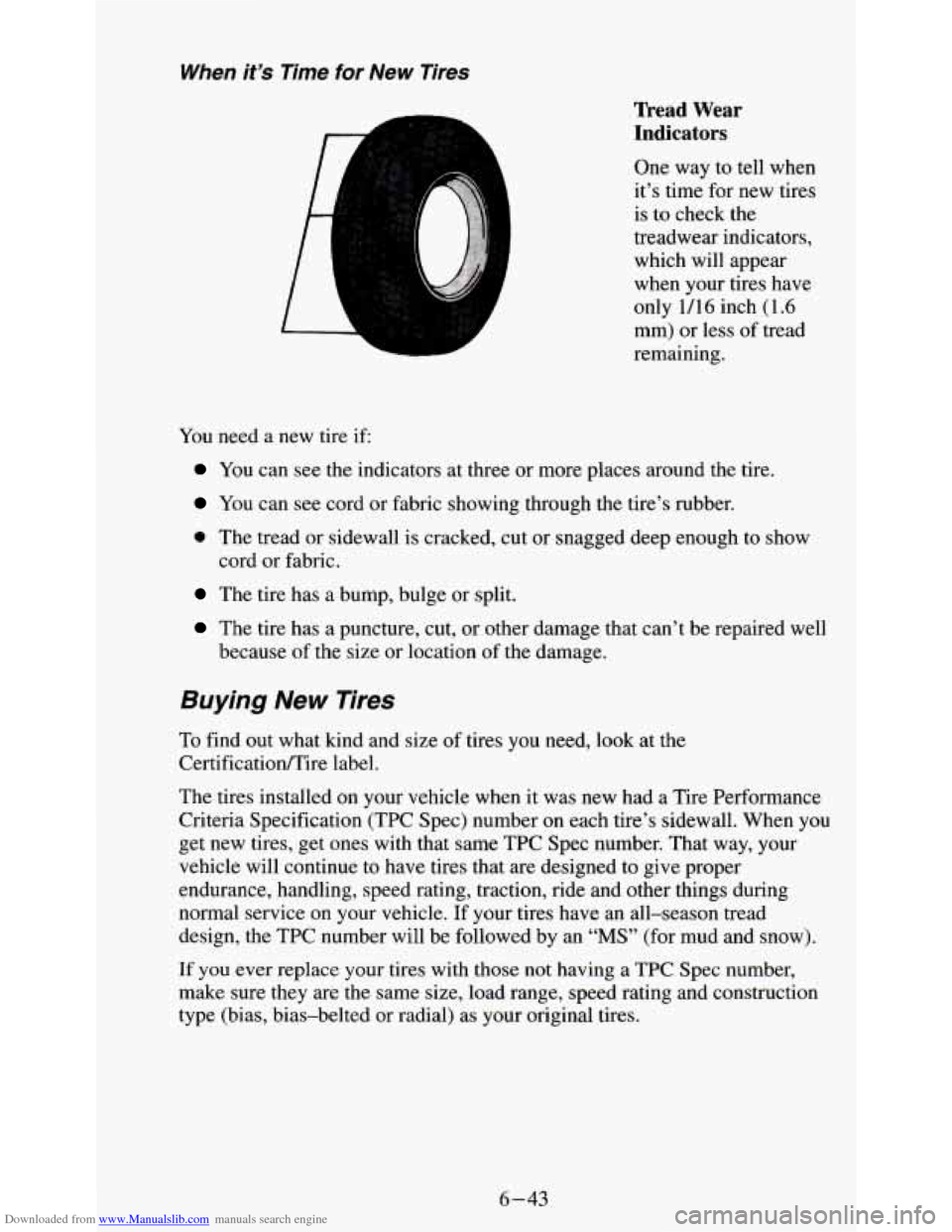
Downloaded from www.Manualslib.com manuals search engine When it’s Time for New Tires
You need a new tire if:
Tread Wear
Indicators
One way to tell when
it’s time for new tires
is to check the
treadwear indicators,
which will appear
when your tires have
only
1/16 inch (1.6
mm) or less of tread
remaining.
You can see the indicators at three or more places around the tire.
You can see cord or fabric showing through the tire’s rubber.
0 The tread or sidewall is cracked, cut or snagged deep enough to show
cord or fabric.
The tire has a bump, bulge or split.
The tire has a puncture, cut, or other damage that can’t be repaired well
because
of the size or location of the damage.
Buying New Tires
To find out what kind and size of tires you need, look at the
Certificationmire label.
The tires installed on your vehicle when it was new had a Tire Performance
Criteria Specification (TPC Spec) number on each tire’s sidewall. When you
get new tires, get ones with that same TPC Spec number. That way, your
vehicle will continue to have tires that are designed
to give proper
endurance, handling, speed rating, traction, ride and other things during
normal service on your vehicle. If your tires have an all-season tread
design, the TPC number will be followed by an
“MS” (for mud and snow).
If you ever replace your tires with those not having a TPC Spec number,
make sure they are the same size, load range, speed rating and construction
type (bias, bias-belted or radial) as your original tires.
6-43
Page 261 of 354
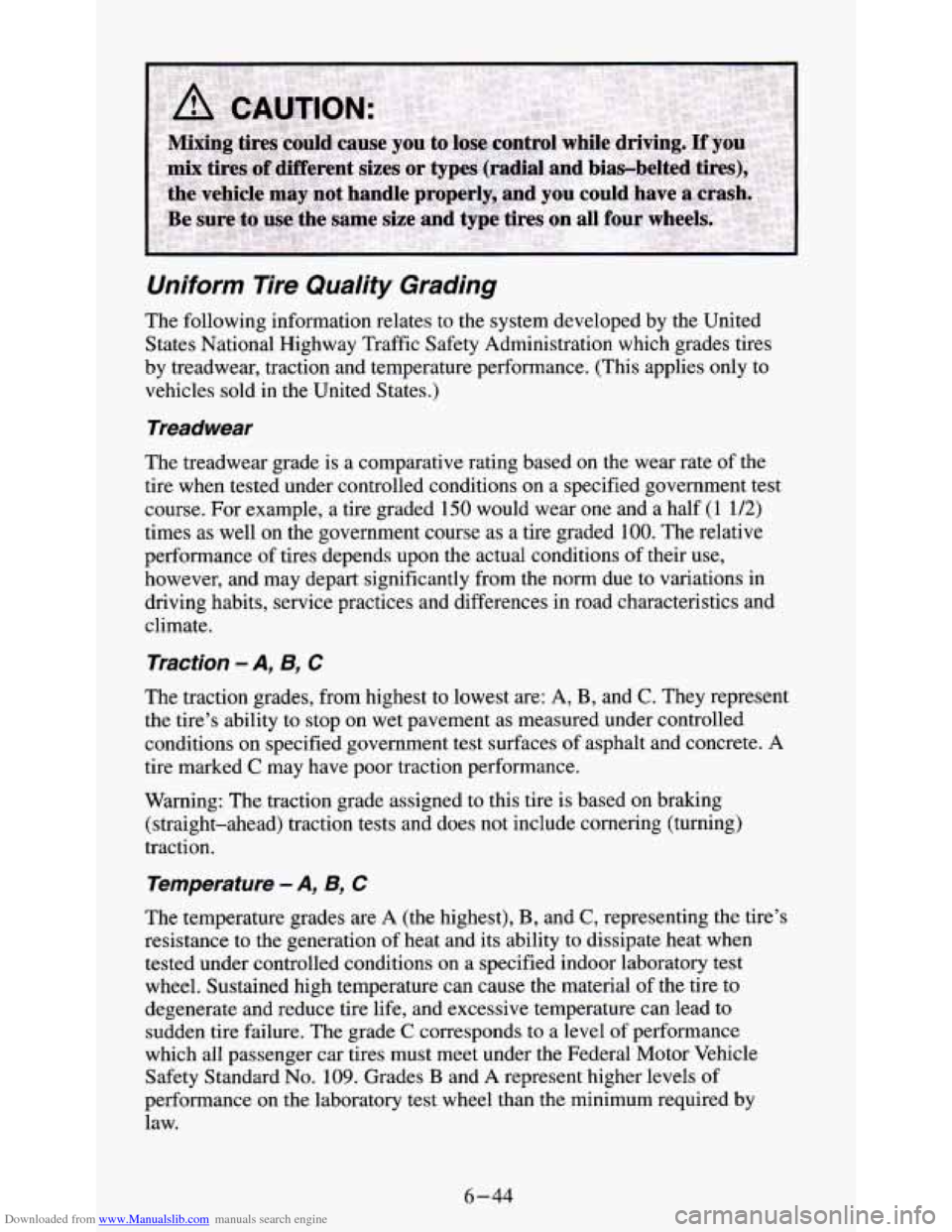
Downloaded from www.Manualslib.com manuals search engine Uniform Tire Quality Grading
The following information relates to the system developed by the United
States National Highway Traffic Safety Administration which grades tires
by treadwear, traction and temperature performance. (This applies only to
vehicles sold in the United States.)
Treadwear
The treadwear grade is a comparative rating based on the wear rate of the
tire when tested under controlled conditions on a specified government test
course. For example, a tire graded
150 would wear one and a half (1 112)
times as well on the government course as a tire graded 100. The relative
performance
of tires depends upon the actual conditions of their use,
however, and may depart significantly from the norm due to variations in
driving habits, service practices and differences in road characteristics and
climate.
Traction -A, By C
The traction grades, from highest to lowest are: A, B, and C. They represent
the tire’s ability to stop on wet pavement as measured under controlled
conditions on specified government test surfaces of asphalt and concrete.
A
tire marked C may have poor traction performance.
Warning: The traction grade assigned to this tire is based on braking
(straight-ahead) traction tests and does not include cornering (turning)
traction.
Temperature - A, 9, C
The temperature grades are A (the highest), B, and C, representing the tire’s
resistance to the generation of heat and its ability to dissipate heat when
tested under controlled conditions on a specified indoor laboratory test
wheel. Sustained high temperature can cause the material
of the tire to
degenerate and reduce tire life, and excessive temperature can lead to
sudden tire failure. The grade
C corresponds to a level of performance
which all passenger car tires must meet under the Federal Motor Vehicle
Safety Standard
No. 109. Grades B and A represent higher levels of
performance on the laboratory test wheel than the minimum required by
law.
6-44
Page 262 of 354
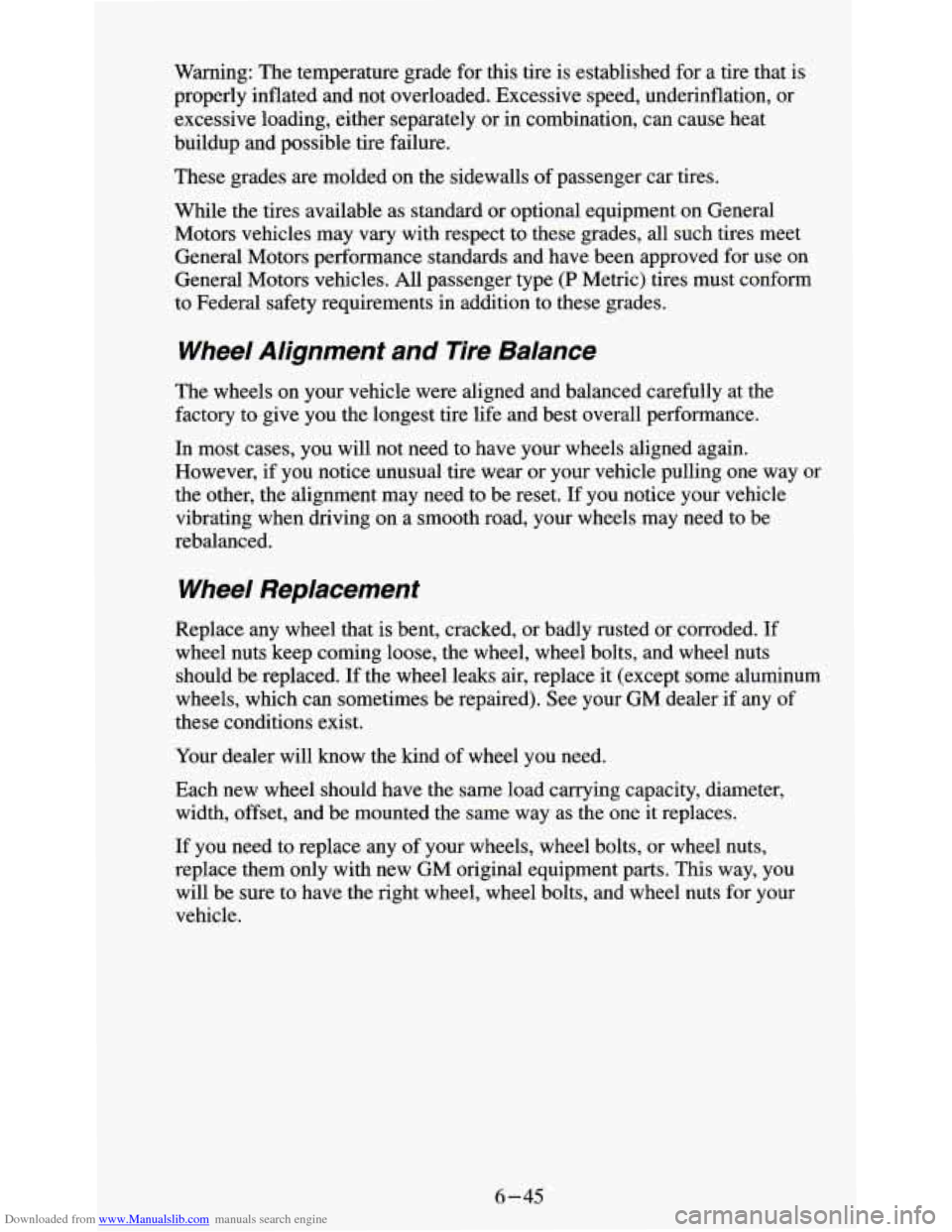
Downloaded from www.Manualslib.com manuals search engine Warning: The temperature grade for this tire is established for a tire that is
properly inflated and not overloaded. Excessive speed, underinflation, or
excessive loading, either separately or in combination, can cause heat
buildup and possible tire failure.
These grades are molded on the sidewalls of passenger
car tires.
While the tires available as standard or optional equipment on General
Motors vehicles may vary with respect to these grades, all such tires meet
General Motors performance standards and have been approved for use on
General Motors vehicles. All passenger type
(P Metric) tires must conform
to Federal safety requirements in addition to these grades.
Wheel Alignment and Tire Balance
The wheels on your vehicle were aligned and balanced carefully at the
factory to give you the longest tire life and best overall performance.
In most cases, you will not need to have your wheels aligned again.
However, if you notice unusual tire wear or your vehicle pulling one way or
the other, the alignment may need to be reset. If you notice your vehicle
vibrating when driving on a smooth road, your wheels may need to be
rebalanced.
Wheel Replacement
Replace any wheel that is bent, cracked, or badly rusted or corroded. If
wheel nuts keep coming loose, the wheel, wheel bolts, and wheel nuts
should be replaced. If the wheel leaks air, replace it (except some aluminum
wheels, which can sometimes be repaired). See your GM dealer if any of
these conditions exist.
Your dealer will know the kind of wheel you need.
Each new wheel should have the same load carrying capacity, diameter,
width, offset, and be mounted the same way as the one it replaces.
If you need to replace any of your wheels, wheel bolts, or wheel nuts,
replace them only with new GM original equipment parts. This way, you
will be sure to have the right wheel, wheel bolts, and wheel nuts for your
vehicle.
6-45
Page 264 of 354
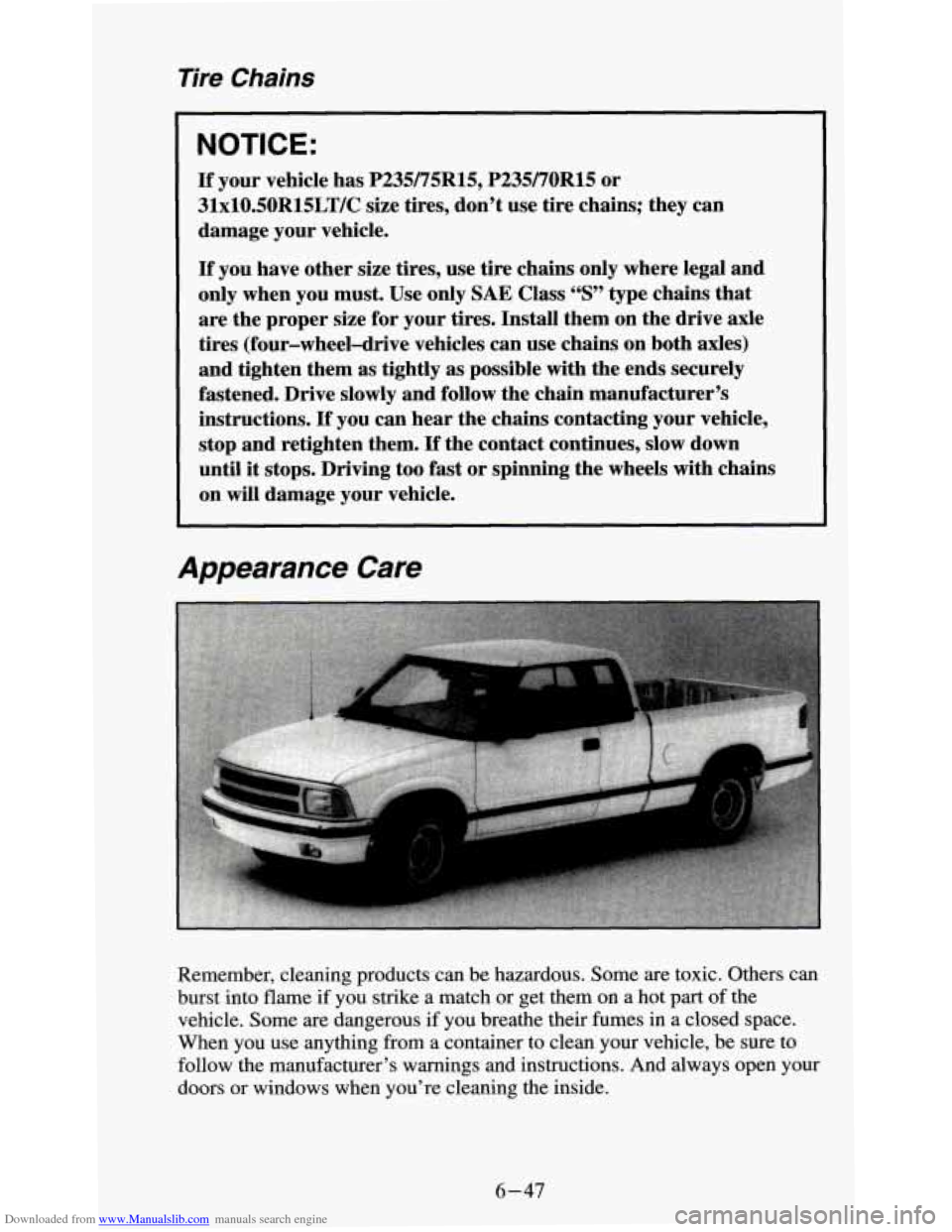
Downloaded from www.Manualslib.com manuals search engine Tire Chains
NOTICE:
If your vehicle has P235/75R15, P235/70R15 or
3lxl0.50R15LT/C size tires, don’t use tire chains; they can
damage your vehicle.
If you have other size tires, use tire chains only where legal and
only when you must. Use only
SAE Class “S” type chains that
are the proper size for your tires. Install them on the drive axle
tires (four-wheel-drive vehicles can use chains on both axles)
and tighten them
as tightly as possible with the ends securely
fastened. Drive slowly and follow the chain manufacturer’s
instructions.
If you can hear the chains contacting your vehicle,
stop and retighten them.
If the contact continues, slow down
until
it stops. Driving too fast or spinning the wheels with chains
on will damage your vehicle.
Appearance Care
Remember, cleaning products can be hazardous. Some are toxic. Others can
burst into flame if you strike
a match or get them on a hot part of the
vehicle. Some are dangerous if you breathe their fumes in a closed space.
When
you use anything from a container to clean your vehicle, be sure to
follow the manufacturer’s warnings and instructions. And always open your
doors
or windows when you’re cleaning the inside.
6-47
Page 271 of 354

Downloaded from www.Manualslib.com manuals search engine NOTICE:
If you have aluminum wheels, don’t use an automatic vehicle
wash that has hard silicon carbide cleaning brushes. These
brushes can take the protective coating
off your aluminum
wheels.
Tires
To clean your tires, use a stiff brush with a tire cleaner.
When applying a tire dressing always take care to wipe
off any overspray or
splash from painted surfaces. Petroleum-based products may damage the
paint finish.
Sheet Metal Damage
If your vehicle is damaged and requires sheet metal repair or replacement,
make sure the body repair shop applies anti-corrosion material to the parts
repaired or replaced to restore corrosion protection.
Foreign Material
Calcium chloride and other salts, ice melting agents, road oil and tar, tree
sap, bird droppings, chemicals from industrial chimneys, and other foreign
matter can damage your vehicle’s finish if they remain on painted surfaces.
Use cleaners that are marked safe for painted surfaces to remove foreign
matter.
Finish Damage
Any stone chips, fractures or deep scratches in the finish should be repaired
right away. Bare metal will corrode quickly and may develop into a major
repair expense.
Minor chips and scratches can be repaired with touch-up materials available
from your dealer or other service outlets. Larger areas of finish damage can
be corrected in your dealer’s body and paint shop.
6-54
Page 273 of 354
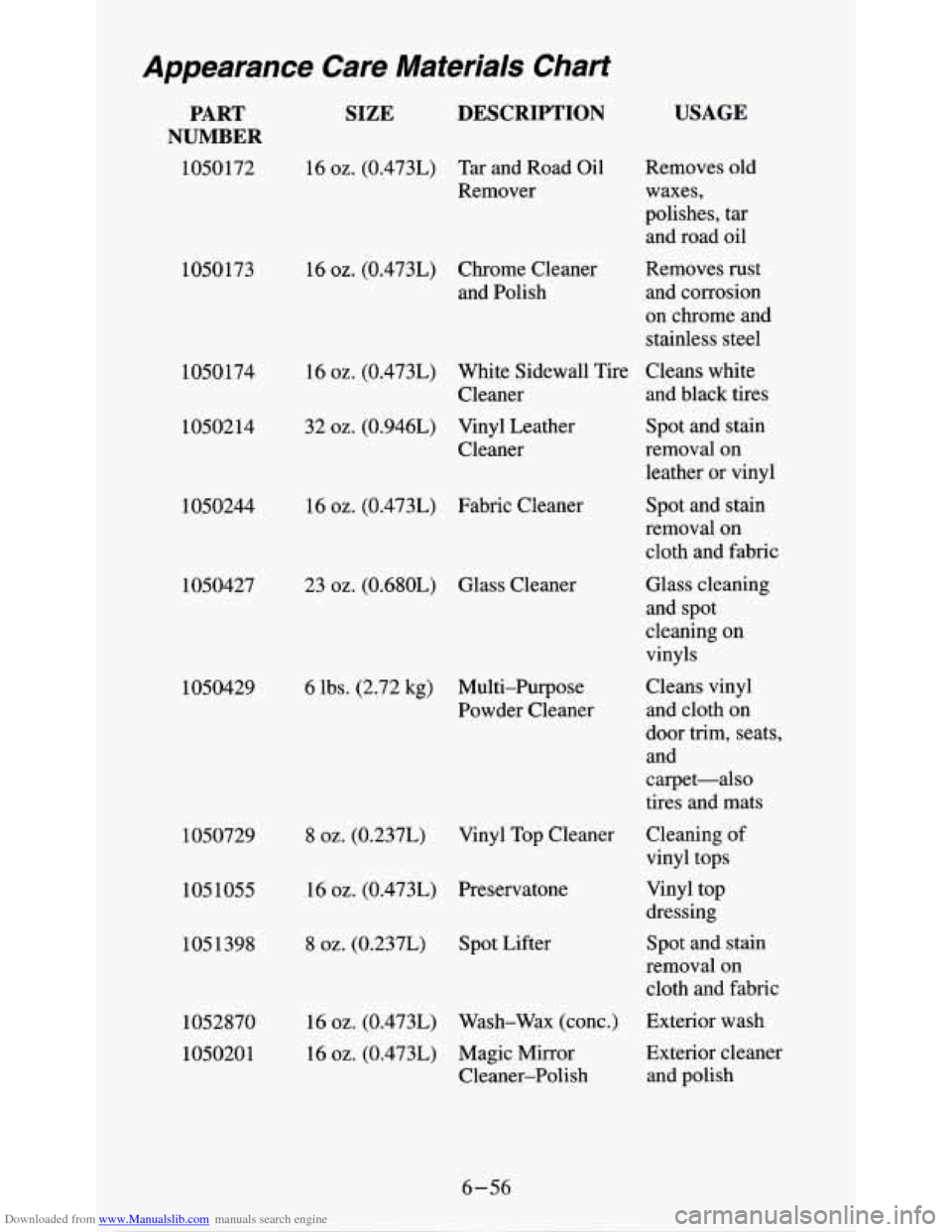
Downloaded from www.Manualslib.com manuals search engine Appearance Care Materials Chart
PART
NUMBER
1050172 1050173
1050174
1050214
1050244 1050427
1050429
1050729 1051055
1051398
1052870
1050201
SIZE DESCRIPTION
16 oz. (0.473L) Tar and Road Oil Remover
USAGE
Removes old
waxes,
polishes, tar
and road oil
16
oz. (0.473L) Chrome Cleaner and Polish Removes rust
and corrosion
on chrome and
stainless steel
16
oz. (0.473L) White Sidewall Tire Cleans white
Cleaner and black tires
32
oz. (0.946L) Vinyl Leather Spot and stain
Cleaner removal on
leather or vinyl
16
oz. (0.473L) Fabric Cleaner
23
oz. (0.680L) Glass Cleaner
6 lbs. (2.72 kg) Multi-Purpose Powder Cleaner
16
oz. (0.473L) Preservatone Spot and stain
removal on cloth and fabric
Glass cleaning
and spot
cleaning on
vinyls
Cleans vinyl and cloth on
door trim, seats,
and
carpet-also
tires and mats
8 oz. (0.237L) Vinyl Top Cleaner Cleaning of
vinyl tops
Vinyl top
dressing
8 oz. (0.237L) Spot Lifter Spot and stain
removal on cloth and
fabric
16 oz. (0.473L) Wash-Wax (conc.) Exterior wash
16
oz. (0.473L) Magic Mirror Cleaner-Polish Exterior cleaner
and polish
Page 296 of 354
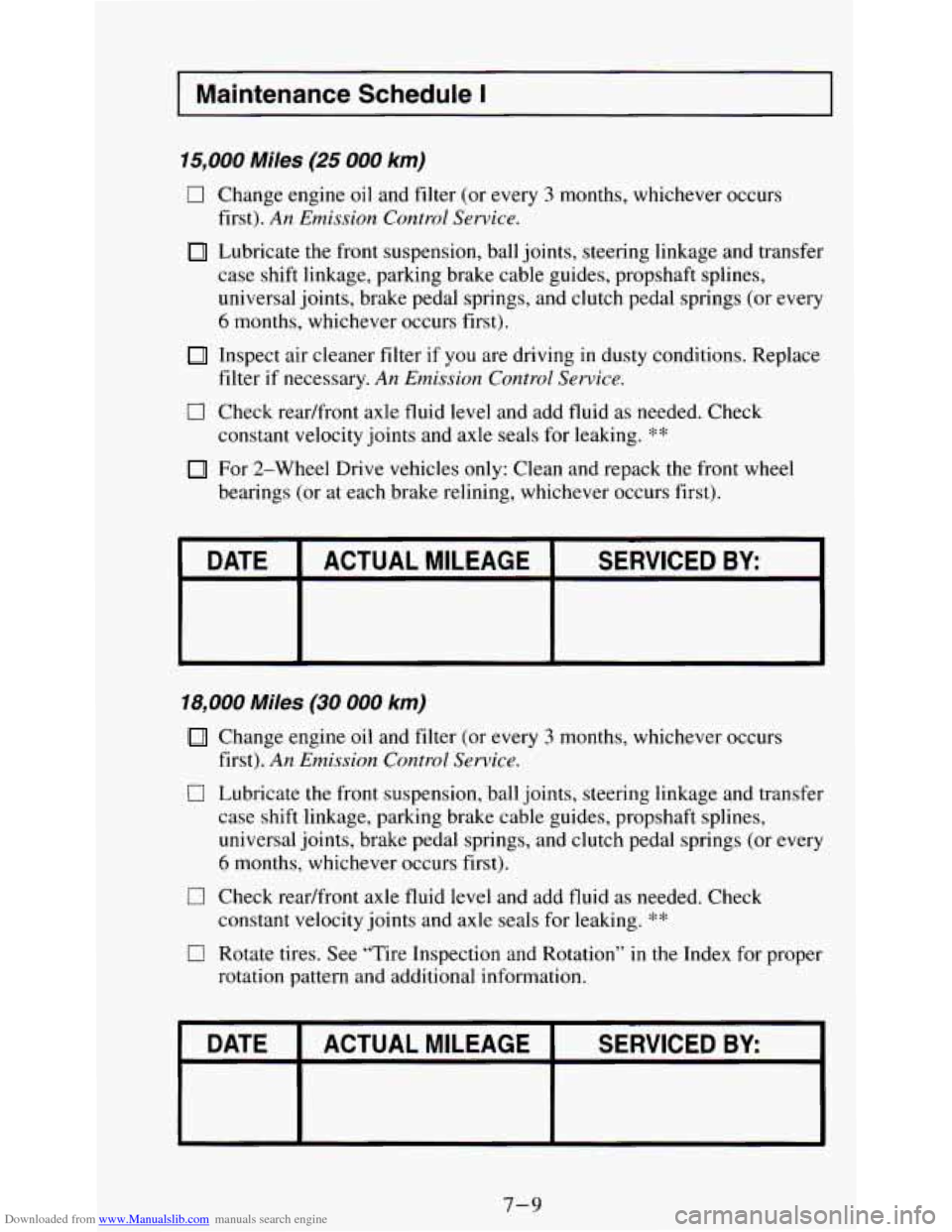
Downloaded from www.Manualslib.com manuals search engine I Maintenance Schedule I
15,000 Miles (25 000 km)
0
0
Change engine oil and filter (or every 3 months, whichever occurs
first).
An Emission Control Service.
Lubricate the front suspension, ball joints, steering linkage and transfer
case shift linkage, parking brake cable guides, propshaft splines,
universal joints, brake pedal springs, and clutch pedal springs (or every
6 months, whichever occurs first).
Inspect air cleaner filter
if you are driving in dusty conditions. Replace
filter
if necessary. An Emission Control Service.
Check readfront axle fluid level and add fluid as needed. Check
constant velocity joints and axle seals for leaking.
**
For 2-Wheel Drive vehicles only: Clean and repack the front wheel
bearings (or at each brake relining, whichever occurs first).
DATE
SERVICED BY ACTUAL MILEAGE
18,000 Miles (30 000 km)
Change engine oil and filter (or every 3 months, whichever occurs
0 Lubricate the front suspension, ball joints, steering linkage and transfer
case shift linkage, parking brake cable guides, propshaft splines,
universal joints, brake pedal springs, and clutch pedal springs (or every
6 months, whichever occurs first).
first).
An Emission Control Service.
0 Check
readfront axle fluid level and add fluid as needed. Check
constant velocity joints and axle seals for leaking.
**
rotation pattern and additional information.
0 Rotate tires. See “Tire Inspection and Rotation” in the Index for proper
DATE
SERVICED BY ACTUAL MILEAGE
7-9
Page 299 of 354
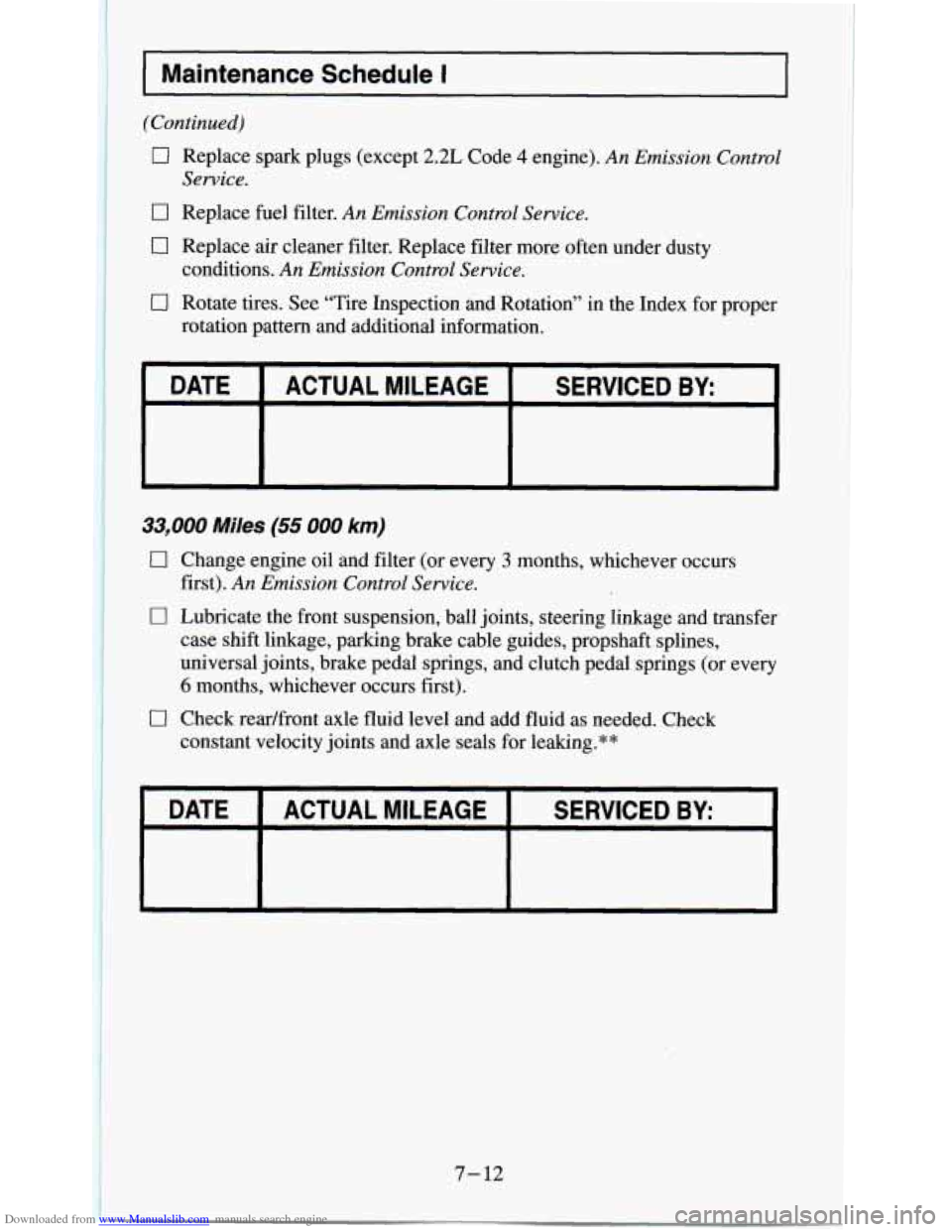
Downloaded from www.Manualslib.com manuals search engine i
I Maintenance Schedule I
(Continued)
0 Replace spark plugs (except 2.2L Code 4 engine). An Emission Control
0 Replace fuel filter. An Emission Control Service.
Service.
0 Replace air cleaner
filter. Replace filter more often under dusty
conditions.
An Emission Control Service.
0 Rotate tires. See “Tire Inspection and Rotation” in the Index for proper
rotation pattern and additional information.
I DATE I ACTUALMILEAGE I SERVICED BY: I
33,000 Miles (55 000 km)
0 Change engine oil and filter (or every 3 months, whichever occurs
first).
An Emission Control Service.
0 Lubricate the front suspension, ball joints, steering linkage and transfer
case shift linkage, parking brake cable guides, propshaft splines,
universal joints, brake pedal springs, and clutch pedal springs (or every
6 months, whichever occurs first).
constant velocity joints and axle seals for leaking.**
0 Check readfront axle fluid level and add fluid as needed. Check
DATE ACTUAL MILEAGE SERVICED BY:
7- 12
I